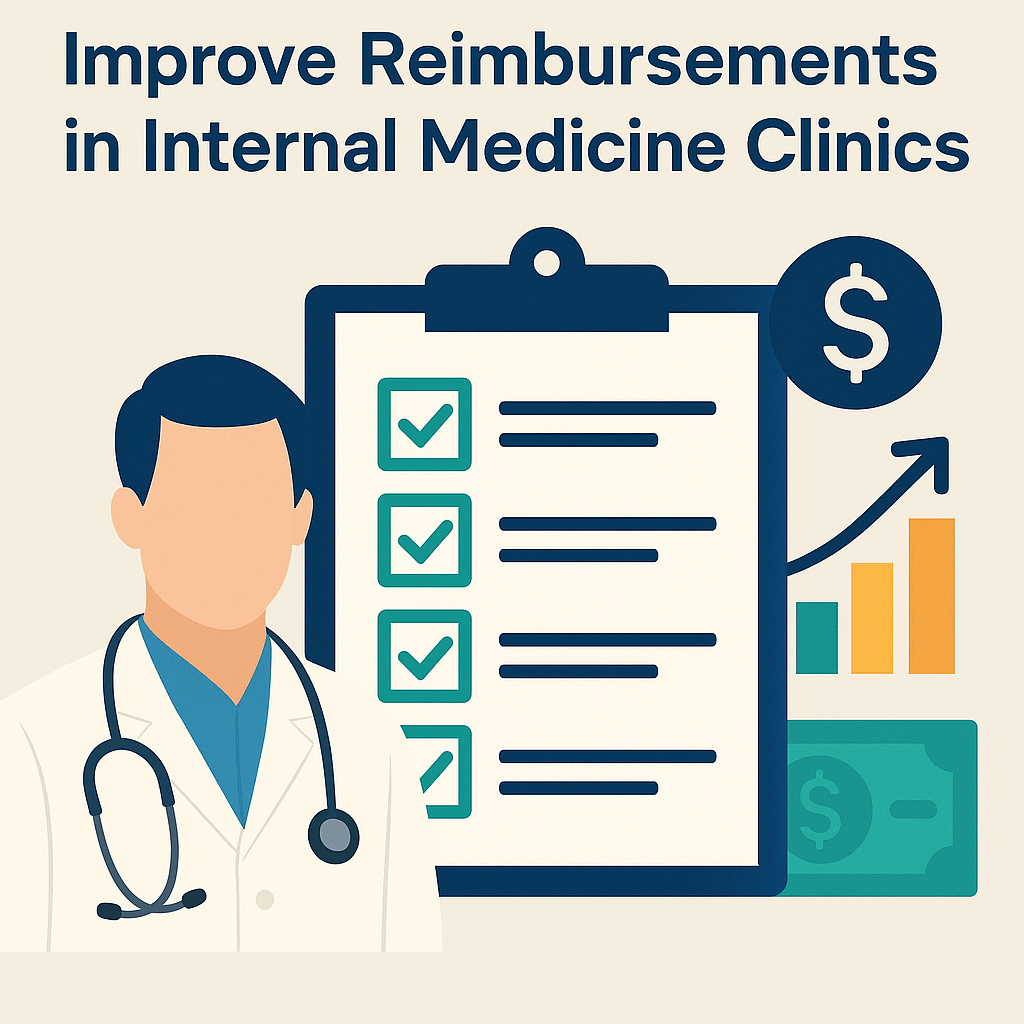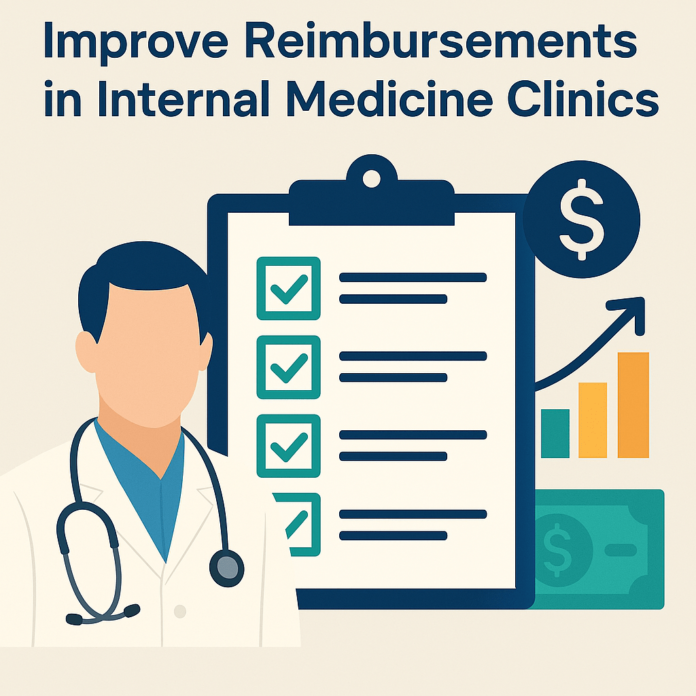Introduction: The Financial Imperative for Internal Medicine Clinics
Internal medicine clinics play a critical role in providing comprehensive care to adults, managing chronic conditions, and offering preventive services. However, despite delivering high-quality care, many internal medicine practices struggle with optimizing reimbursements from insurers. Inaccurate billing, coding errors, inefficient processes, and compliance issues often lead to claim denials and delayed payments, which can strain a clinic’s cash flow and hinder its growth.

Improving reimbursements is not just about financial survival—it is essential for reinvesting in patient care, upgrading technology, and expanding services. In this comprehensive guide, we delve into the strategies that internal medicine clinics can implement to enhance their billing processes and boost revenue. From understanding the key factors that influence reimbursements to leveraging advanced technologies and optimizing workflows, this article provides actionable insights tailored specifically for internal medicine practices.
1. Understanding Reimbursements in Internal Medicine
1.1 The Role of Reimbursements in Healthcare
Reimbursements are the payments healthcare providers receive from insurance companies, Medicare, Medicaid, and patients for the services rendered. For internal medicine clinics, timely and accurate reimbursements are critical, as they directly affect cash flow, operational efficiency, and overall financial health.
1.2 Unique Challenges in Internal Medicine Billing
Internal medicine involves a wide range of services—from routine check-ups and chronic disease management to complex diagnostic evaluations. These services often involve:
- Comprehensive Patient Evaluations: Longer visits that require detailed documentation.
- Multiple Coexisting Conditions: Patients often present with several chronic illnesses that complicate billing.
- Preventive and Wellness Services: Some services may not be fully reimbursed or might have lower reimbursement rates.
These challenges necessitate an in-depth understanding of billing processes and a robust strategy for capturing the full value of services provided.
2. Key Factors Influencing Reimbursements in Internal Medicine
2.1 Accurate Medical Coding
Accurate coding is the foundation of effective billing. Internal medicine requires precise use of:
- ICD-10 Codes: For diagnoses.
- CPT Codes: For procedures and services.
- HCPCS Codes: For medical supplies and certain services not covered by CPT codes.
Errors in coding—whether undercoding or overcoding—can lead to significant revenue losses. Undercoding results in lower reimbursements, while overcoding may trigger audits and penalties.
2.2 Thorough Documentation
Detailed clinical documentation supports the billing process by:
- Justifying Medical Necessity: Accurate documentation ensures that each service is medically justified.
- Supporting Claims: Comprehensive records help insurers verify the services provided.
- Reducing Denials: Detailed notes reduce the likelihood of claim denials and ensure compliance with payer requirements.
2.3 Charge Capture Efficiency
Charge capture involves recording every service and supply provided to a patient. In internal medicine:
- Missed Charges: Even small oversights in charge capture can lead to significant revenue leakage over time.
- Efficiency in Data Entry: Automation in capturing charges during patient visits can drastically reduce errors.
- Timely Billing: Ensuring all services are billed promptly leads to faster claim submissions and reimbursements.
2.4 Insurance Verification and Pre-Authorization
Proper insurance verification ensures that:
- Patient Eligibility is Confirmed: Accurate insurance details reduce claim rejections.
- Pre-Authorization is Obtained: For services that require approval, timely authorization prevents denials.
- Patient Responsibility is Clearly Defined: Accurate verification helps set patient expectations, reducing disputes later.
2.5 Payer-Specific Guidelines and Compliance
Each payer—whether Medicare, Medicaid, or private insurance—has unique guidelines:
- Contractual Variations: Understanding the specifics of each contract ensures that the clinic bills the correct rates.
- Regulatory Changes: Staying updated on policy changes is essential for maintaining compliance and maximizing reimbursements.
- Internal Policies: Developing internal guidelines that reflect payer requirements can standardize the billing process and reduce errors.
3. Best Practices for Maximizing Reimbursements
3.1 Implement Advanced Revenue Cycle Management (RCM) Software
Investing in modern RCM software can revolutionize the billing process:
- Integration: Seamless integration with Electronic Health Records (EHR) ensures that all patient data flows smoothly from clinical documentation to billing.
- Automation: Automated claim submission and real-time eligibility checks reduce manual errors.
- Analytics: Advanced reporting tools help monitor key performance indicators (KPIs) such as denial rates, reimbursement turnaround times, and revenue leakage.
3.2 Optimize Charge Capture Processes
Ensure that every service is captured and billed accurately:
- Real-Time Data Entry: Use mobile devices or tablets for immediate data capture during patient visits.
- Standardized Workflows: Develop standard operating procedures (SOPs) for charge capture to ensure consistency.
- Regular Audits: Conduct periodic internal audits to identify and rectify missed charges.
3.3 Enhance Coding Accuracy through Continuous Training
Regular training for coding staff is essential:
- Certification Programs: Encourage staff to obtain certifications such as CPC (Certified Professional Coder) or CCS (Certified Coding Specialist).
- Ongoing Education: Provide regular training sessions on updates to ICD-10, CPT, and HCPCS codes.
- Audit Feedback: Use feedback from internal audits to address recurring coding errors.
3.4 Streamline Insurance Verification and Pre-Authorization
Improve your verification processes:
- Real-Time Tools: Implement real-time insurance verification software to confirm patient eligibility before services are rendered.
- Standard Procedures: Create clear protocols for verifying insurance details and obtaining pre-authorizations.
- Patient Communication: Educate patients about the importance of updating their insurance information and understanding their coverage.
3.5 Foster Collaboration Among Departments
Effective communication between clinical, billing, and coding teams is key:
- Interdepartmental Meetings: Schedule regular meetings to discuss billing challenges and updates.
- Shared Goals: Establish shared performance metrics that focus on reducing denials and optimizing reimbursements.
- Feedback Loops: Encourage staff to provide feedback on process improvements and use this data to refine workflows.
3.6 Leverage Data Analytics for Continuous Improvement
Data-driven insights can transform your billing process:
- Monitor KPIs: Track key performance indicators such as claim denial rates, reimbursement turnaround time, and revenue leakage.
- Identify Trends: Use analytics to identify recurring issues and areas for improvement.
- Benchmarking: Compare your performance against industry standards to gauge success and guide improvements.
4. Leveraging Technology to Enhance Reimbursements
4.1 Automation and AI in Billing
Automation can dramatically improve efficiency:
- AI-Powered Coding Assistance: Use AI to assist in assigning the correct codes based on clinical documentation, reducing human error.
- Automated Claims Submission: Leverage tools that automatically scrub and submit claims to ensure accuracy and speed.
- Predictive Analytics: Employ predictive analytics to forecast revenue trends and identify potential denials before they occur.
4.2 Cloud-Based Solutions
Cloud technology offers flexibility and scalability:
- Remote Accessibility: Cloud-based RCM systems enable staff to access billing data from any location, facilitating faster decision-making.
- Scalable Infrastructure: Cloud platforms can easily accommodate growth, ensuring that your system remains robust as patient volumes increase.
- Enhanced Security: Leading cloud-based systems offer advanced security measures to protect sensitive patient and financial data.
4.3 Integration with EHR Systems
Seamless integration is critical:
- Unified Data Flow: Ensure that your EHR and RCM systems communicate effectively to eliminate data silos.
- Real-Time Updates: Integration allows for real-time data exchange, reducing delays in charge capture and billing.
- Streamlined Reporting: A unified system provides comprehensive analytics, enabling better performance tracking and operational adjustments.
5. Case Studies: Real-World Examples of Optimized Reimbursements
5.1 Case Study: Small Primary Care Practice
A small primary care clinic was facing significant revenue leakage due to incomplete charge capture and frequent claim denials. By investing in an integrated EHR and RCM system with real-time insurance verification and automated charge capture, the clinic achieved:
- A 20% reduction in claim denials due to improved coding and documentation.
- Faster reimbursements with a 25% decrease in claim processing times.
- Increased revenue capture as every billable service was recorded accurately.
- Enhanced staff efficiency, allowing administrative teams to focus on patient care.
5.2 Case Study: Multi-Specialty Clinic
A multi-specialty clinic implemented advanced analytics tools and automated workflows to optimize its revenue cycle management. As a result:
- Claim denial rates dropped by 30%, thanks to better documentation and coding practices.
- Revenue leakage was reduced by identifying and addressing missed charges promptly.
- Cash flow improved significantly, with reimbursements processed faster and more accurately.
- Interdepartmental collaboration improved, leading to a more cohesive approach to billing and coding.
These case studies highlight how optimizing the revenue cycle through enhanced charge capture, streamlined workflows, and technology integration can result in significant financial benefits for healthcare providers.
6. Future Trends in Revenue Cycle Optimization for Primary Care
6.1 Artificial Intelligence and Machine Learning
AI and ML are poised to further revolutionize revenue cycle management:
- Advanced Predictive Analytics: Future systems will use AI to predict revenue trends and identify potential issues before they occur.
- Intelligent Automation: Enhanced automation will handle more complex billing tasks, reducing the burden on staff and minimizing errors.
- Continuous Learning: Machine learning algorithms will continuously adapt to new coding standards and payer guidelines, ensuring ongoing optimization.
6.2 Blockchain Technology
Blockchain offers promising solutions for secure and transparent billing:
- Immutable Audit Trails: Blockchain ensures that every charge is recorded in an unalterable ledger, enhancing compliance and reducing fraud.
- Data Security: Blockchain’s decentralized nature provides robust protection against data breaches and unauthorized access.
- Streamlined Audits: With transparent, blockchain-based records, the audit process becomes more straightforward and less resource-intensive.
6.3 Enhanced Interoperability and Cloud Integration
The future of RCM lies in seamless data integration:
- Unified Systems: Greater interoperability between EHR, RCM, and billing systems will eliminate data silos and improve overall efficiency.
- Real-Time Collaboration: Cloud-based solutions will facilitate real-time data sharing and collaboration, enabling faster decision-making and improved performance.
- Scalability: As healthcare practices grow, integrated cloud solutions will scale effortlessly, maintaining high performance and data integrity.
7. Best Practices for Sustaining Continuous Improvement
7.1 Regular Staff Training and Certification
- Ongoing Education: Regularly train staff on the latest billing practices, coding updates, and technological tools.
- Certification Programs: Encourage staff to pursue certifications to ensure they remain proficient in current industry standards.
- Cross-Training: Facilitate cross-training between clinical, coding, and billing teams to foster a better understanding of the entire revenue cycle.
7.2 Continuous Process Audits
- Internal Audits: Conduct regular internal audits to identify gaps in the billing process and ensure that all services are accurately captured.
- Performance Metrics: Monitor key performance indicators (KPIs) such as claim denial rates, reimbursement turnaround times, and revenue leakage.
- Feedback Loops: Establish feedback mechanisms where staff can report issues and suggest improvements, ensuring that the process is continuously refined.
7.3 Leveraging Technology and Vendor Partnerships
- Technology Refresh: Regularly evaluate and upgrade your RCM software to leverage the latest advancements.
- Vendor Collaboration: Work closely with software vendors to customize solutions to your practice’s needs and address emerging challenges.
- Data Analytics: Use advanced analytics to drive strategic decisions and identify areas for further optimization.
8. Conclusion: Optimizing Revenue Through Effective Charge Capture
Optimizing the revenue cycle in primary care practices is a multifaceted challenge that requires a strategic approach, advanced technology, and continuous improvement. By focusing on accurate charge capture, streamlining billing processes, and leveraging technology such as AI, cloud-based solutions, and blockchain, internal medicine clinics can significantly improve their reimbursements, reduce claim denials, and enhance overall financial performance.
The strategies outlined in this guide—from integrated systems and real-time analytics to comprehensive staff training and regular audits—offer a roadmap for internal medicine practices to optimize their revenue cycle management. In today’s competitive healthcare landscape, practices that invest in these best practices will not only maximize their revenue but also improve patient satisfaction and operational efficiency.
At ClinicBillingHelp.com, we are dedicated to providing healthcare providers with the latest insights, best practices, and technological innovations to optimize every aspect of revenue cycle management. Explore our comprehensive resources to learn more about improving billing processes, reducing revenue leakage, and ensuring your practice remains financially robust.
Start transforming your revenue cycle today by embracing advanced technologies and continuous improvement strategies. Empower your practice to achieve a seamless, efficient billing process that drives growth and ensures long-term financial stability.




